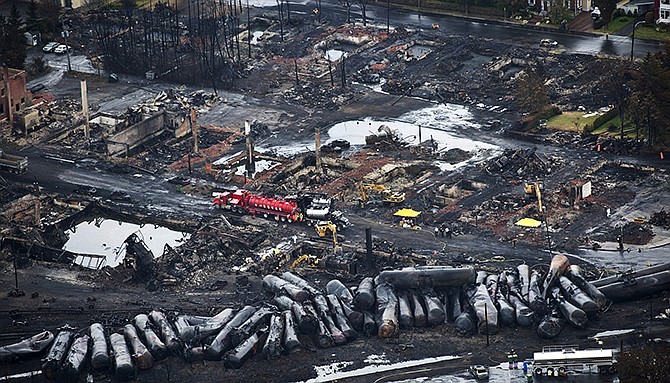BILLINGS, Mont. (AP) - At least 10 times since 2008, freight trains hauling oil across North America have derailed and spilled significant quantities of crude, with most of the accidents touching off fires or catastrophic explosions.
The derailments released almost 3 million gallons of oil, nearly twice as much as the largest pipeline spill in the U.S. since at least 1986. And the deadliest wreck killed 47 people in the town of Lac-Megantic, Quebec.
Those findings, from an Associated Press review of U.S. and Canadian accident records, underscore a lesser-known danger of America's oil boom, which is changing the global energy balance and raising urgent safety questions closer to home.
Experts say recent efforts to improve the safety of oil shipments belie an unsettling fact: With increasing volumes of crude now moving by rail, it's become impossible to send oil-hauling trains to refineries without passing major population centers, where more lives and property are at risk.
Adding to the danger is the high volatility of the light, sweet crude from the fast-growing Bakken oil patch in Montana and North Dakota, where many of the trains originate. Because it contains more natural gas than heavier crude, Bakken oil can have a lower ignition point. Of the six oil trains that derailed and caught fire since 2008, four came from the Bakken and each caused at least one explosion. That includes the accident at Lac-Megantic, which spilled an estimated 1.6 million gallons and set off a blast that levelled a large section of the town.
After recent fiery derailments in Quebec, Alabama, North Dakota and New Brunswick, companies and regulators in the U.S. and Canada are pursuing an array of potential changes such as slowing or rerouting trains, upgrading rupture-prone tank cars and bolstering fire departments. Company executives were expected to offer a set of voluntary safety measures in the coming days at the request of U.S. Transportation Secretary Anthony Foxx.
"I'm absolutely positive the railway industry will come up with techniques to define how to minimize risk," said Allan Zarembski who leads the rail-safety program at the University of Delaware. "The key word is "minimize.' You can't eliminate risk."
Since 2008, the number of tanker cars hauling oil has increased 40-fold, and federal records show that's been accompanied by a dramatic spike in accidental crude releases from tank cars. Over the next decade, rail-based oil shipments are forecast to increase from 1 million barrels a day to more than 4.5 million barrels a day, according to transportation officials.
By rail, it's roughly 2,000 miles from the heart of the oil boom on the Northern Plains to some of the East Coast refineries that turn the crude into gasoline. Trains pulling several million gallons apiece must pass through metropolitan areas that include Minneapolis, Chicago, Cleveland and Buffalo.
Some cities such as Chicago have belt railroads that divert freight traffic from the metropolitan core. But elsewhere, railroad representatives said, the best-maintained and safest track often runs directly through communities that were built around the railroad.
Trains sometimes have no option but to roll deep into populated areas. That's the case in Philadelphia, New Orleans, Albany, N.Y., and Tacoma, Wash.
Experts say the explosive nature of Bakken oil derailments caught everyone off guard - from regulators to the railroads themselves.
"I don't think people understood the potential for a problem if there were a derailment," said Jason Kuehn, a former railroad executive and now vice president for the industry consulting firm Oliver Wyman.
A major accident was narrowly avoided last month in Philadelphia, where six tanker cars carrying oil derailed near the heart of the city on a bridge over the Schuylkill River. The CSX freight train had picked up North Dakota oil in Chicago and was headed for a refinery in South Philadelphia. Nothing was spilled, but the accident rattled nerves.
Sandy Folzer, a retired professor in Philadelphia, said she worries about oil cars travelling alongside commuter rails.
"During rush hour, I imagine there are a couple hundred people on each train," Folzer said. "That scares me, that there's explosive material so close to where commuters are."
Proposals to route trains away from population centers are modeled on rules adopted after the 2001 terrorist attacks to restrict cargoes even more hazardous than oil - explosives, radioactive material and poisonous gases.
When the rules were being written, California regulators pushed their federal counterparts to include oil. But Transportation Department officials said they were "not persuaded."
Federal safety officials say it's time to reverse that decision, given the huge growth in tank cars carrying crude and ethanol, another flammable liquid involved in recent derailments and explosions.
The rules gave railroads broad discretion, and routing decisions are not automatically reviewed by regulators. But the Federal Railroad Administration is authorized to reject any routes found to be too risky. That has never happened since the rules took effect, said FRA Associate Administrator Kevin Thompson.
Even where trains can be re-routed through less-populous areas, critics say that simply shifts the risk to smaller communities with fewer resources to handle a fiery accident. Rural and suburban municipalities in Maine, Illinois and Vermont already have pushed back against the proposal.
In Hartford, Vt., Town Manager Hunter Rieseberg said it was "a fantasy" to think that moving hazardous shipments through rural areas would resolve safety problems.

